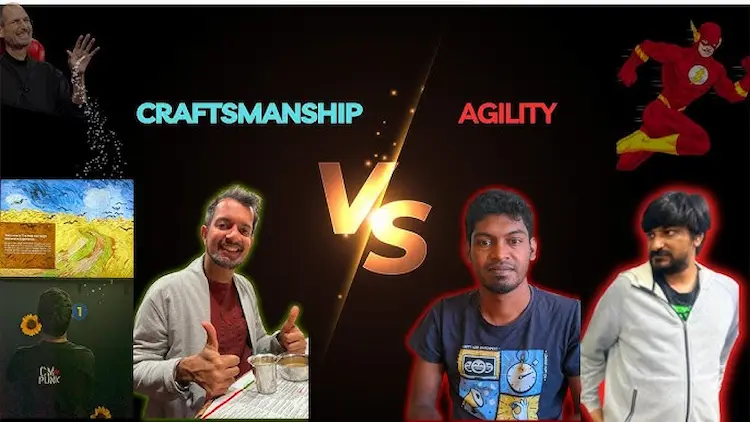In the fast-paced world of software development, the challenge is delivering not just functional code but delivering exemplary software—maintainable, scalable, and adaptable to change. This is where the concepts of software craftsmanship and agile methodologies converge, offering developers a blueprint for success.
This article explores how these two approaches complement each other and how you can leverage agile strategies to craft high-quality software that stands the test of time.
What is Software Craftsmanship?
Software craftsmanship is the art of writing clean, maintainable, and efficient code. It’s a mindset where coding isn’t just about getting things to work; it’s about doing it with care, precision, and an eye toward long-term sustainability. Craftsmanship focuses on mastering your tools, following best practices, and always seeking to improve.
Key principles include:
- SOLID: Ensuring code is modular, scalable, and adheres to object-oriented principles.
- DRY (Don’t Repeat Yourself): Avoid duplication in code by centralizing logic.
- KISS (Keep It Simple, Stupid): Focusing on simplicity in design and avoiding over-complication.
Craftsmanship isn’t just for individual developers; it’s about cultivating a culture within your team that prioritizes quality, mentorship, and continuous learning.

Agile Methodologies: The Power of Flexibility
While craftsmanship focuses on quality, agile methodologies emphasize adaptability and continuous improvement. Agile approaches like Scrum, Kanban, and Extreme Programming (XP) break development into smaller, manageable chunks, allowing for frequent feedback and iterative refinement.
Agile’s core principles—working software over documentation, customer collaboration, and responding to change—align perfectly with the goals of craftsmanship. By working in small iterations, developers have the freedom to refine, improve, and polish their code continuously.

Related Post: Preview Environments: The Secret to Agile Software Development
Strategies for Crafting Exemplary Software
Now, let’s get into specific strategies that combine agile practices with craftsmanship principles to craft exemplary software.
Incremental Development
In agile, the focus is on delivering software in small, bite-sized pieces. This approach prevents the build-up of unnecessary complexity and allows developers to concentrate on quality.
How to Apply It:
- Break large features into smaller, shippable increments.
- Deliver working code frequently, allowing time for refinements in future sprints.
- Use each iteration to enhance the software’s design, usability, and performance.
Breaking down features into smaller chunks minimizes risks, gains user feedback early, and ensures the final product is polished.
Test-Driven Development (TDD)
TDD is one of the most powerful techniques to ensure that your code is of high quality from the start. The idea is simple: write the test first, then write the code to make the test pass. This ensures that your software is built to be testable, maintainable, and correct.
Benefits of TDD:
- Reduces bugs and ensures edge cases are handled.
- Encourages simple, modular code.
- Acts as a living documentation of your software’s expected behavior.
For example, let’s say you’re building a function to calculate discounts. With TDD, you would first write a test to check that the discount is applied correctly, and only then would you write the actual discount calculation logic. This ensures the code is both correct and minimal—no unnecessary complexity.
Continuous Refactoring
Agile development thrives on change, and refactoring is a critical part of that. Refactoring means cleaning up your code as you go—improving its structure without changing its behavior.
Agile practices like continuous integration encourage developers to refactor frequently. In every iteration, take time to revisit older parts of the codebase and improve its structure, naming conventions, or performance.
How to Refactor in Agile:
- After every feature or sprint, look for areas where the code can be simplified or improved.
- Make refactoring part of your team’s definition of “done” for every story.
- Keep an eye on code smells—signs that your code needs attention, like overly long methods or duplicated logic.
Collaborative Practices: Pair Programming, Mob Programming, and Code Reviews
Collaboration is key to both agile and craftsmanship. Practices like pair programming and code reviews help foster a shared sense of ownership and maintain high-quality standards throughout the codebase.
- Pair Programming: Two developers work on the same piece of code together. This practice encourages knowledge sharing and reduces the likelihood of mistakes.
- Code Reviews: Before merging any code into the main branch, it should go through a review process. This not only improves the quality but also ensures consistency across the team.
Both practices also promote a culture of learning. More experienced developers can mentor juniors, helping them grow into craftsmen themselves.
Continuous Integration/Continuous Delivery (CI/CD)
Agile teams aim to deliver software quickly and frequently, and CI/CD pipelines are the perfect tools to ensure this happens without sacrificing quality.
With CI, every time code is pushed to the repository, it’s automatically tested and integrated into the main codebase. This ensures that errors are caught early, and the codebase is always in a releasable state.
CD goes a step further by automatically deploying code to production after it passes tests, ensuring rapid and reliable releases.
Balancing Craftsmanship and Agility

Craftsmanship vs. Deadlines
One of the most significant challenges in real-world development is balancing high-quality code with tight deadlines. Agile sprints often demand quick turnarounds, which can tempt developers to cut corners.
How to Manage This:
- Set Realistic Goals: Break tasks into manageable increments to avoid overwhelming sprints.
- Prioritize: Focus on the most critical features first, and use future sprints to refine and improve the code.
- Make Refactoring Part of the Plan: Treat refactoring as an ongoing activity rather than a luxury.
Avoiding Over-engineering
While craftsmanship encourages clean and thoughtful code, it’s essential to avoid the trap of over-engineering. Sometimes, the simplest solution is the best, especially in agile environments where you’re iterating and adapting frequently.
Focus on what’s necessary for now. If additional complexity isn’t required immediately, leave it for a future sprint.
Key Takeaways: Craftsmanship in an Agile World
- Continuous Learning: As a developer, always strive to improve your craft. Follow coding standards, read about new techniques, and practice.
- Frequent Feedback: Agile’s iterative nature provides constant opportunities for feedback. Use it to your advantage, both through testing and collaboration.
- Adaptability: Stay flexible and responsive, while maintaining the discipline to write high-quality, maintainable code.
By blending agile strategies with the craftsmanship mindset, developers can create not just working software, but exemplary software that is built to last.
Conclusion on Codecraft: Agile Strategies for Crafting Exemplary Software

Software development is a craft. By combining agile methodologies with software craftsmanship, you create the perfect blend of adaptability and quality. The key is to stay disciplined in your coding practices while embracing the iterative, flexible nature of agile.
Your code should not only work—it should work well, be maintainable, and be a joy to improve. The strategies outlined above provide a solid foundation for achieving just that.
Start small—introduce pair programming, adopt TDD, or simply dedicate time to refactoring. Over time, these practices will become second nature, and your codebase will reflect the principles of true Codecraft.
Further Reading by Our Recommended Sources
- Agile Manifesto
- Clean Code by Robert C. Martin
- The Pragmatic Programmer by Andrew Hunt and David Thomas
- Test-Driven Development: By Example by Kent Beck
- Agile Estimating and Planning by Mike Cohn
- Extreme Programming Explained by Kent Beck